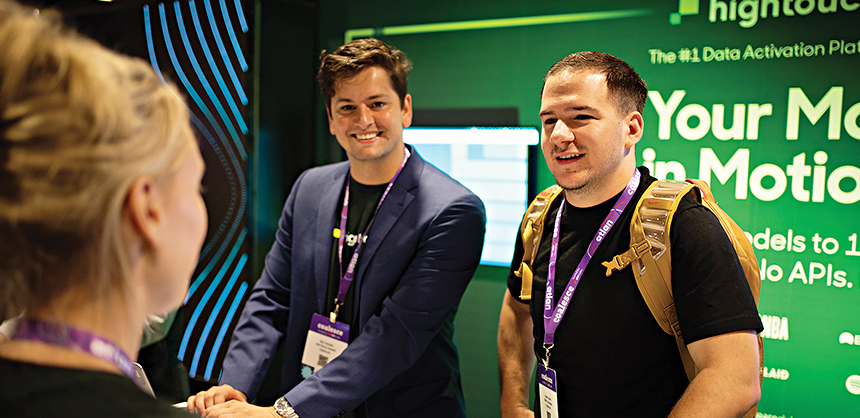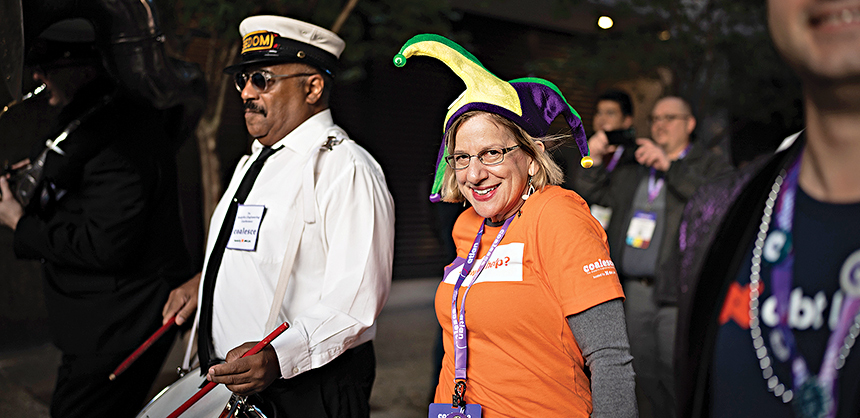Creating an ExperienceJune 26, 2023
While Keeping Attendees Engaged & Secure By Chloe LaBelleCreating an Experience
While Keeping Attendees Engaged & Secure
Create ways for attendees to stay engaged through participation and networking, like at Coalesce, pictured, a premier analytics engineering conference. Photo by Lucid Media
There’s a reason why so many corporate meeting and incentive events seem to be cookie cutter productions. Over the decades the meetings and events industry has established a protocol of sorts that many planners follow to ensure a meeting goes off without a hitch. And while following a standard practice of conducting events that have been proven to deliver is understandable, today’s attendees want something more – they seek experiences that are engaging, intriguing and safe at the same time.
From her experience, Yvette Campbell, CMP, meeting planner at Meetings Made Easy, says group attendees are wanting a lot more interaction with meetings and events since the pandemic. Gone are the days where you enter a room, listen to a speaker, have lunch and end the day with a cocktail hour. Elements such as interesting activation stations and team-building experiences are becoming the norm.
“We are all looking for more human touches, connecting to a charitable organization or even doing something out of the norm,” Campbell says. “I have seen events connecting with the local animal shelter to have an adoption site and play pen available to guests to take a furry friend home.”
Campbell also is seeing meetings incorporating team-building experiences – simple scavenger hunts around the hotel or city to learn about the facility, or learn about interesting things in areas that pertain to the event.
“The key is to create an experience rather than just an event. By taking an experiential approach, attendees become part of the program rather than just spectators,” says Heather Wilson, CMP, founder of The Brand Strategy Tank.
Wilson points to several attributes that make today’s events truly engaging. These include:
- Interactive experiences: Give attendees opportunities to engage in interactive experiences that allow them to participate actively in the event rather than just being passive observers.
- Personalization and belonging: It doesn’t matter if an attendee is in the c-suite or the beginning of their career. They want to feel that they belong. Attendees want events that are tailored to their individual interests and needs.
“Personalized recommendations for sessions based on role, customized agendas and targeted networking opportunities can help make attendees feel more engaged and invested in the event,” Wilson says. “Creating a feeling of belonging means being intentional about inclusion. This should be woven into the fabric of all events. Creating accessibility guides for all events underscores the importance of inclusion and lets all attendees know their needs are considered.”
- Networking: Time and again, survey feedback tells us that attendees value networking opportunities as a way to connect with others, exchange ideas and learn from each another. Events should facilitate meaningful networking as a best practice.
- High-quality content: Content should be educational and not promotional. Attendees will call you out if it isn’t. Events should feature content that is relevant, up-to-date and presented in an engaging way. From keynote speakers to breakout sessions, attendees want to leave the event feeling informed and inspired.
- Technology enablement: Attendees expect events to incorporate technology that enhances their overall experience, such as event apps with the ability to make timely announcements (i.e., lunch begins in 15 minutes), augmented reality experiences, and the option of virtual and hybrid event formats.
- Sustainability and social responsibility: Wilson is regularly asked about sustainability efforts and publishes reports following events, as attendees are increasingly conscious of the impact events have on the environment and community.
“Events that prioritize sustainability and social responsibility are likely to appeal to attendees who are looking for value-aligned events,” Wilson says. Add food donation clauses to your contracts – there are laws in place to protect you and the venue, and you can use these to push back on venues who use the excuse of ‘potential liabilities,’ as an excuse not to make this important effort.”
At a recent event that Wilson orchestrated, she challenged sponsors to create “activation stations” that were relevant to their business versus traditional booths at the expo hall.
“Attendees and sponsors loved it, though sponsors were a bit apprehensive at first. Having no badge scanners was a bit controversial, but flying in the face of the status quo isn’t always comfortable. You have to dare to be different,” Wilson says. One sponsor has an origami swan as part of their logo and had an origami folding station. Another had people silkscreen their own t-shirts. And even another one set up a 1950’s diner. This format provided for fun, organic conversations and “wow” moments at every turn rather than the quid pro quo of a piece of swag in exchange for scanning a name badge on an expo hall floor where attendees feel like they’ve already walked many times before.
“The feedback was that it felt like a fun, low-pressure, professional carnival or fair. The social media engagement stats and sign-ups for trials with the company were the highest they’d ever seen,” Wilson says. “The authenticity and engagement that came out of it is something that can’t be bought.
Something that hasn’t worked is speakers and keynotes taking place during meals. It’s noisy and distracting for the speaker to hear people clinging forks and glasses. As Wilson points out, attendees also feel self-conscious making noise while eating.
“The banquet staff can be disruptive refreshing tables, and attendees are unable to socialize during a time that should be theirs to network, enjoy their meal and take a break from content,” Wilson says. “Sometimes, less is more.”
That said, Campbell also recommends engaging events that boast full agendas with a mixture of education, relaxation and human connection times.
“Consider featuring entertainment offered during breaks – make it different, use local talent from surrounding schools and [organizations],” Campbell says. “Try to involve the local community or do an activity that gives back to the community.”

Create ways for attendees to stay engaged through participation and networking, like at Coalesce, pictured, a premier analytics engineering conference. Photo by Lucid Media
Striving To Be Engaging
Wilson says it is imperative to have clear goals and objectives for meetings and events and to provide these to attendees at the onset. Answer the question, “Why should I attend this conference over another?”
“Provide a clear explanation of the ROI for attendees. They need to know what to expect and what value the event will deliver for them,” Wilson says. “This is especially important when they are trying to convince their leadership to pay for their attendance at business events.”
If an attendee feels lost or doesn’t know where to go – this will create a poor experience and the engagement factor will immediately decrease. “If speakers are not engaging or become promotional, attendees will see through it and disengage. Further, poor time management will take the wind out of attendees’ sails,” Wilson says. “If sessions run over, or there are too many concurrent sessions happening at once, which forces attendees to choose between too many sessions, they will become frustrated. Social events and meals starting too late or early will also have negative effects on engagement and attendee satisfaction.”
Meeting planning professional, Deven Crane, director of travel services at Incentive Solutions, says that meeting technology is moving forward quickly, so we have to stay ahead of the curve.
“Augmented reality is a great new way to engage and ‘wow’ attendees,” Crane says. “Also, mobile apps, interactive displays and gamification help make the event much more interactive. Interactivity including group activities, breakout sessions and roundtables always give attendees fun opportunities to collaborate, engage and network with each other.”
Crane’s clients, the trip sponsors, look for opportunities for their attendees to team build and network. The attendees love immersing themselves in local culture whenever they can. Whether it’s through food, music, art or other activities, they want to experience something unique that they can’t get anywhere else. Interestingly, sustainable and socially responsible activities have become more and more attractive over the past few years.
“We have a lot of people wanting to do activities like hiking, kayaking, wildlife watching or visiting cultural landmarks,” says Crane. “However, spas and golfing continue to be the most popular activities. I guess some trends will never fade!”
Crane points to two main elements that will ensure high engagement:
- Managing the flow of events, activities and private time. If anyone ever is confused as to what is happening, then you’re doing it wrong, and other attendees are probably wondering the same thing. That leads to confusion and people distrusting the planners.
- The activities and the content drive engagement. If it’s an activity that is new or exciting, attendees will be likely to show up and join. If the meeting is topical, with content that will benefit them, they’re going to participate.
“Without both factors, attendees will not engage because they can’t, or they don’t want to,” Crane says. “Honestly, you can just tell when an event isn’t going well. People aren’t participating or mingling. Over time you learn how to read the room.”
Tim Heffernan, chief growth and development officer at T3 Expo, says it’s important to vary the format of an event. Long lectures can be tiring, so it’s important to put more of the conversations on the show floor.
“Incorporating pavilions, such as mini-theaters, is a great way to hyper-localize content for a specific subset of the audience. For example, a cybersecurity pavilion would give specific 10 to 20 minute talks on how to protect different parts of a critical infrastructure,” Heffernan says.
It’s all about creating shareable moments. Here are some specific examples that Heffernan offers:
• Action on the show floor: Attendees want to be actively involved in the event rather than being pitched to, or just sitting and listening. Incorporate edutainment opportunities on the show floor through pavilions and interactive activities, and also include live polling, Q&A sessions, breakout sessions, networking opportunities and hands-on workshops.
- Personalization: Attendees want events that are tailored to their interests and needs. They want to be able to choose sessions that are relevant to their industry, job role or specific interests. Personalization can also come in the form of custom branding, personalized emails and individualized content.
- Innovation: Attendees want events that are cutting-edge, creative and unique. They want to experience the latest technology, new event formats and physical environments that will leave a lasting impression. Innovation can include things like augmented reality, gamification and interactive installations.
“Overall, attendees want events that are engaging, informative and shareable,” Heffernan says. “They want to feel like they are part of a community and have the opportunity to connect with like-minded individuals. By incorporating these engagement aspects, event organizers can create a successful and impactful event that resonates with attendees.”
However, he adds, it’s important to avoid overloading attendees with too many activities or information, as this can lead to burnout and disengagement. It’s also crucial to listen to quantitative, qualitative and emotional feedback from attendees, and make adjustments for future events based on their suggestions and preferences.

Having a contingency plan in place for in person events is essential in case there is an emergency. Courtesy of Deven Crane
Safety Is Key
While event planners want events to be engaging, they also need to be safe. From creatively and safely meeting in person post-pandemic to being vigilant about active shooter awareness, safety is paramount. Some large events are requiring security checks and attendees to walk through metal detectors.
Indeed, engaging and safe events go hand-in-hand. According to James Hayes, vice president of sports and entertainment at Guidepost Solutions, a security consultancy, the risk level associated with meetings or events depends on many factors, not limited to the area the event is to be held, controversiality of topic, demographic of participants, and any known threats against the organizers.
“Events or meetings about controversial topics, events or meetings held in high crime areas, and events or meetings involving participant groups known to be disruptive or combative should be assessed to determine if enhanced security protocols should be implemented,” Hayes says.
Of course, every event has different needs based on risk. Assess the risk to an event based on the specifics of the event. For venues, Hayes recommends having flexible security procedures that allow security assets to be increased depending on the risk associated with the event.
“We recommend approaching every event or meeting as a single security task order as opposed to having one standard for the venue,” Hayes says.
As a best practice, Wilson says it’s crucial for organizers to conduct a thorough risk assessment and implement appropriate safety measures to ensure attendee safety. This requires a safety and risk plan.
“For each locale, laws will vary. Meetings with the fire marshal and calls with the local police department can help shape the plan,” Wilson says.
In addition to a clear code of conduct that attendees must agree to upon registration, for each event Wilson orchestrates, she creates a location-specific safety and risk document. This is an accordance with local laws and in collaboration with the venue, fire and police departments.
“During pre-conference, I walk through the plan with the security team and do a check-in with the fire marshal once I’ve arrived onsite to ensure that egresses are to satisfaction and no changes have been made to the fire exit plan,” she adds.
Probably the largest safety concern Crane can remember in all his years as a planner was the COVID-19 pandemic. “Planners needed to adjust just about everything with in person meetings as well as evolve into virtual events,” Crane says. “With that being in the rearview mirror now, we still need to think about safety while traveling out of the country on foreign lands. Crime is in every city but having knowledge of local ‘hot spots’ is something that always need to be thought about and planned around.”
And while many planners focus immediately on the attributes that will make an event engaging, they often procrastinate on making sure the event is safe.
“The biggest mistake I see in today’s environment is procrastination,” Hayes says. “The longer you wait to assess the risk to an event and address security concerns, the more challenging it is to hire vendors and the more expensive it is to adequately staff the event. It’s also critical to identify who is responsible for the security of a meeting or event. Is the venue contractually obligated to provide security? Are the organizers contractually obligated to engage with local law enforcement or a private security force? These are things that are sometimes overlooked.” C&IT










